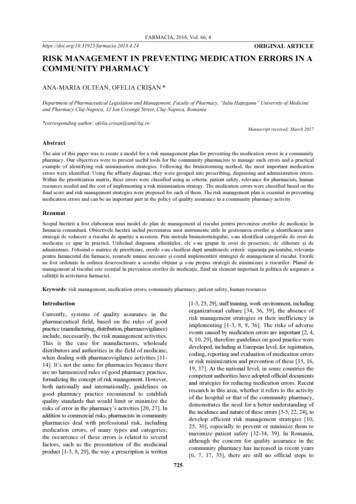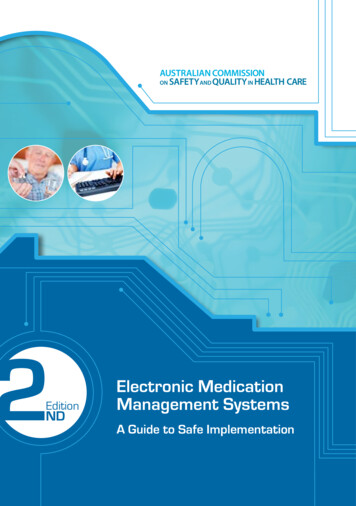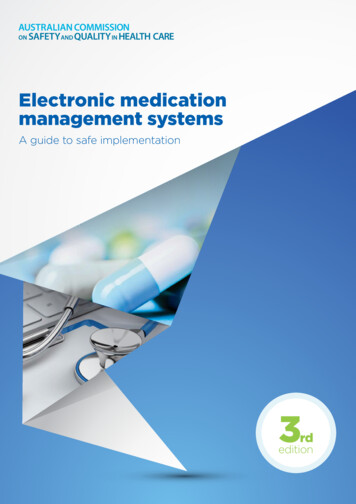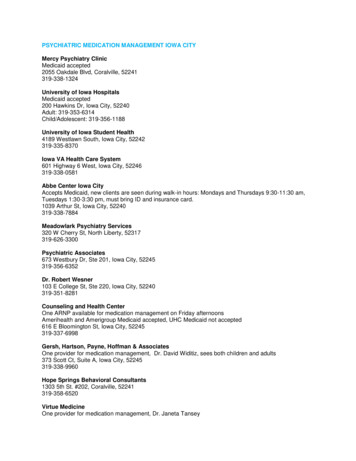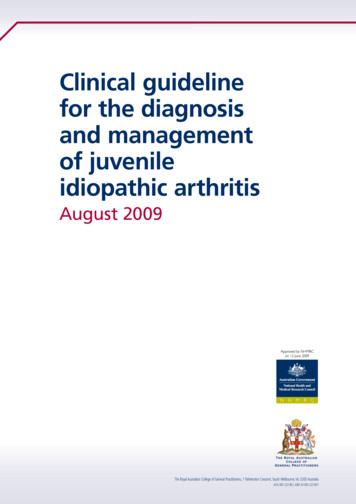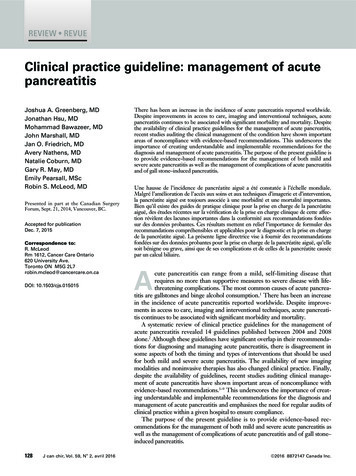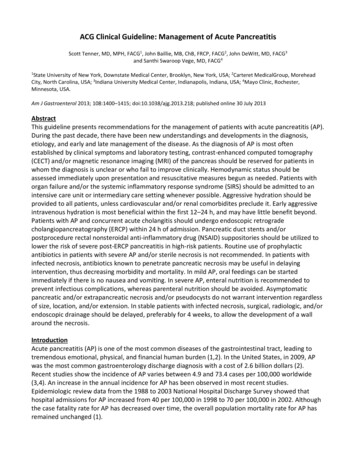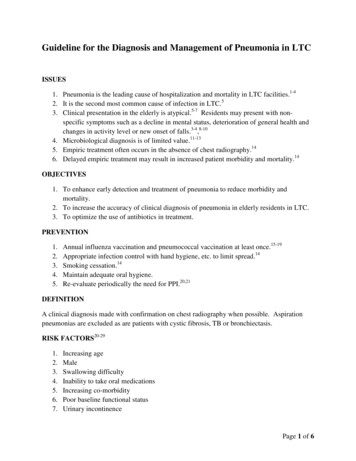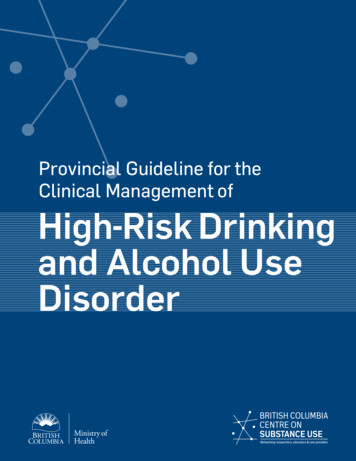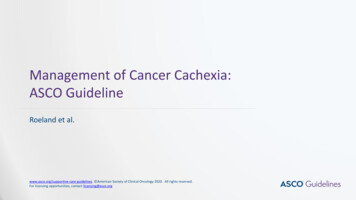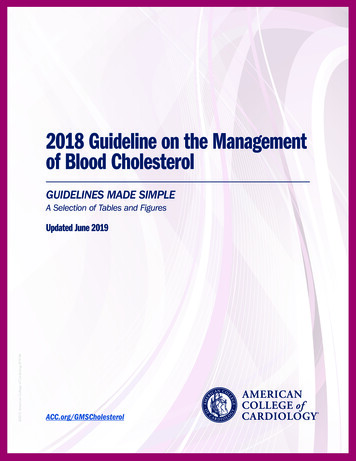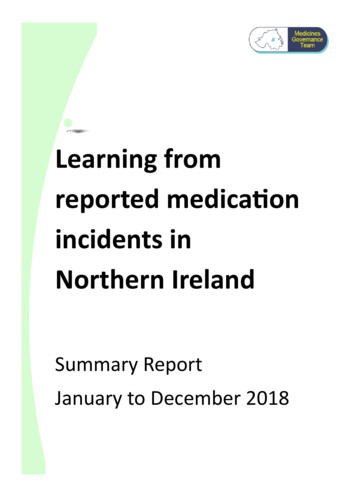
Transcription
MedicationManagementGuidelineApproved and adopted 04/2006Revised 2007, 2010, 2012by theBest Practice Committee of theHealth Care Association of New Jersey4 AAA Drive, Suite 203, Hamilton, NJ 08691-1803Tel: 609-890-8700www.hcanj.org 2012. Permission granted to copy documents with attribution to theBest Practice Committee of the Health Care Association of New Jersey.1
HCANJ Best Practice Committee’sMedication Management GuidelineTable of ContentsPageDisclaimer3I.II.III.IV.Limited Scope of Medication Management GuidelineObjectivesIntended Use of Medication Management GuidelineDefinitions445-88 - 13V.Risk Points and Risk Reduction Strategies13-19VI.Quality Improvement19-20VII.Education20-21VIII.Exhibits22 Safety Related Recommended Policies and Things To Consider22 Medication Reconciliation Form23 Medication Occurrence / Error Report24-25 Provider Pharmacy Report26 Medication Occurrence / Error Tracking Checklist27 Medication Order / Prescription Tracking Checklist28 Medication Administration Monitoring Form29 ISMP Dangerous Drug Interactions In Long Term Care30 Medication Related Laboratory Test Monitoring Policy (Sample guideline)31 ADR Classifications—Naranjo’s Algorithm32 Related Internet Sites33 Bibliography / Reference Citing34-382
HCANJ Best Practice Committee’sMedication ManagementBest Practice GuidelineDisclaimer: This Best Practice Guideline is presented as a model only by way of illustration. It has notbeen reviewed by counsel. Before applying a particular form to a specific use by your organization, itshould be reviewed by counsel knowledgeable concerning applicable federal and state health care lawsand rules and regulations. This Best Practice Guideline should not be used or relied upon in any waywithout consultation with and supervision by qualified physicians and other healthcare professionalswho have full knowledge of each particular resident’s case history and medical condition.This Best Practice Guidelines is offered to nursing facilities, assisted living communities, residentialhealth care facilities, adult day health services providers and other professionals for informational andeducational purposes only.The Health Care Association of New Jersey (HCANJ), its executers, administrators, successors, andmembers hereby disclaim any and all liability for damage of whatever kind resulting from the use,negligent or otherwise, of all Best Practice Guidelines herein.This Best Practice Guideline was developed by the HCANJ Best Practice Committee (“Committee”), agroup of volunteer professionals actively working in or on behalf of health care facilities in NewJersey, including skilled nursing facilities, sub-acute care and assisted living providers.The Committee’s development process included a review of government regulations, literature review,expert opinions, and consensus. The Committee strives to develop guidelines that are consistent withthese principles: Relative simplicityEase of implementationEvidence-based criteriaInclusion of suggested, appropriate formsApplication to various long term care settingsConsistent with statutory and regulatory requirementsUtilization of MDS (RAI) terminology, definitions and data collectionAppropriate staff (Management, Medical Director, Physicians, Nurse-Managers, Pharmacists,Pharmacy Consultants, Interdisciplinary Care Team) at each facility/program should develop specificpolicies, procedures and protocols to best assure the efficient, implementation of the Best PracticeGuideline’s principles.The Best Practice Guidelines usually assume that recovery/rehabilitation is the treatment or care plangoal. Sometimes, other goals may be appropriate. For example, for patients receiving palliative care,promotion of comfort (pain control) and dignity may take precedence over other guideline objectives.Guidelines may need modification to best address each facility, patient and family’s expectations andpreferences.Recognizing the importance of implementation of appropriate guidelines, the Committee plans to offereducation and training. The HCANJ Best Practice Guidelines will be made available at www.hcanj.org. 2012. Permission granted to copy documents with attribution to theBest Practice Committee of the Health Care Association of New Jersey.3
I.LIMITED SCOPE OF MEDICATION MANAGEMENT GUIDELINEThe HCANJ Best Practice Committee (“Committee”) constructed alimited scope guideline intended to assist health care providers withthe development and implementation of systems and strategies thatthe Committee believes will reduce medication errors and promotebest patient/resident outcomes in health care facilities.(see section III)A.Providers interested in expanding their information-basebeyond this Guideline are referred to page 33 of thisguideline for a list of topic-related internet sites.B.This Guideline does not include information about theclinically appropriate use of specific medications. It isnot intended to be used as a resident-specific ormedication-specific guideline.C.The Guideline assumes that all services are provided inaccordance with regulatory requirements and standardsof professional practice.II.OBJECTIVESTo provide information, tools and systems intended to:A.Reduce the incidence of medication errors in health care facilities.B.Improve the quality of care and quality of life foradults living or convalescing in health care facilities.C.Outline strategies for prescribing, dispensing, delivering,storing, administering and monitoring medications.D.1.Guidelines for psychotropic drug reduction2.Guidelines for opiod use (Wash and Utah)Reduce risk and professional liability.Note: The term “resident” refers to all of the following:“patient”, “resident”, “client”, “participant”4
III.INTENDED USE OF MEDICATION MANAGEMENT GUIDELINEA.FACILITIES: This medication management guideline is intended for useby health care facilities and programs, including: Sub-acute Care Facilities Comprehensive Personal Care Homes Skilled Nursing Facilities Assisted Living Programs Nursing Facilities Residential Health Care Facilities Assisted Living Communities Hospice ProgramsAdult Day Health FacilitiesFacilities are encouraged to use this guideline to assist them with thedevelopment and establishment of the following:1. Administrative policies and procedures.2. Clinical policies and procedures.3. Roles and responsibilities of staff and committees, including (but notlimited to):a) Physician, nursing staff and pharmacistsb) Pharmacy and Therapeutics Committeec) Quality Improvement Committeed) Safety Committee4. Design and implementation of operational systems.5. Employee orientation and training guides.6. Quality Improvement processes.B.PROFESSIONALS1. Provider Pharmacist Pharmacies that provide services to long-termcare facilities, assisted living and residential settings (post-acutehealthcare settings) are encouraged to use this best practice guidelineto establish appropriate pharmacy provider systems including thefollowing:a) Design and implement efficient and safe provider pharmacyprocesses including the receipt and processing ofprescriptions, dispensing, delivery, returns and storage ofmedication.5
b) Assist with the design of an efficient and safe medicationprocess within the facility, including procedures for controlledsubstances and psychotropic medicationsc) Establish communication protocols among the providerpharmacy, consultant pharmacist, facility, physicians,residents, families and others.d) Implement policies and procedures including, but not limitedto, the following:1) Receipt of medication orders.2) Creation and implementation of resident records,including Physician Order Sheets (POS), MedicationAdministration Record (MAR) and TreatmentAdministration Record (TAR).3) Labeling of medications with appropriate instructionsfor use and precautions.4) Safe protocols for filling prescriptions.a. Monitoring drug regimensb. Psychotropic Medication Reduction Protocolsc. Opioid Guidelines5) Safe protocols for handling returned and controlledmedications.e) Participation in the Pharmacy and Therapeutics and QualityImprovement Committees.2. Consultant Pharmacist. While not required in all settings or all states,it is a suggested best practice to include regularly scheduled reviewsby a pharmacy consultant.a) Consultant Pharmacists are encouraged to use this BestPractice Guideline to assist with the adoption of appropriatestandards within their client facilities, in collaboration with therespective provider pharmacy, the facility and the MedicalDirector or primary physicians.6
b) Pharmacy Consultants provide oversight of medicationrelated processes including, but not limited to, the following:1) Development and implementation of policies andprocedures, including procedures for controlledsubstances.2) Review and monitoring of all resident drug regimens.3) Recommendations for improvement to processes,policies, procedures, etc.4) Direct or indirect participation with InterdisciplinaryCare Plan (IDCP team and process.5) Inspection of medication storage areas andrecommendations.6) Training and monitoring of licensed nursing andmedical staff performance.7) Serving as an active member of the Pharmacy andTherapeutics Committee, Infection Control Committee,and Quality Improvement Committee.8) Acting as a resource for medication managementsystems.9) Review of procedures for proper disposal anddisposition of medications.3. Medical Directors. Medical Directors are encouraged to use the bestpractice guideline to ensure safe and appropriate medicationmanagement standards are maintained by:a) Reviewing prescriber and facility practices.b) Assisting in the development, implementation andenforcement of medication-related policies and procedures.c) Reviewing provider and pharmacy consultant reports andsupporting and initiating appropriate action.d) Reviewing prescriptive practices of physicians and otherpractitioners and providing constructive feedback asnecessary.7
e) Promoting nursing and physician education.f) Reviewing adverse medication events and recommendinginitiatives to reduce or eliminate future adverse events.4. Physicians and Other Prescribing Practitionersa) Follow the Board of Medical Examiners regulations.b) Provide accurate and complete orders including indications foruse.c) Address Pharmacy Consultant recommendations.d) Follow all medication-related policies, regulations andstandards of care.IV.DEFINITIONSAdverse Consequence An unpleasant symptom or event that is due to or associated with amedication, such as impairment or decline in an individual's mental or physicalcondition or functional or psychosocial status. It may include various types of adversedrug reactions and interactions (e.g., medication-medication, medication-food, andmedication-disease).Adverse Drug Reaction (ADR) A form of adverse consequences. It may be either a secondaryeffect of a medication that is usually undesirable and different from the therapeuticeffect of the medication or any response to a medication that is noxious and unintendedand occurs in doses for prophylaxis, diagnosis, or treatment. The term side effect isoften used interchangeably with ADR; however, side effects are but one of five ADRcategories, the others being hypersensitivity, idiosyncratic response, toxic reactions, andadverse medication interactions. A side effect is an expected, well-known reaction thatoccurs with a predictable frequency and may or may not constitute an adverseconsequence.Adverse Medication Event Includes adverse consequences, adverse drug reactions andmedication errors.Anticholinergic Side Effect An effect of a medication that opposes or inhibits the activity ofthe parasympathetic (cholinergic) nervous system to the point of causing symptoms suchas dry mouth, blurred vision, tachycardia, urinary retention, constipation, confusion,delirium, or hallucinations.8
Behavioral Interventions Individualized non-pharmacological approaches (including directcare and activities) that are provided as part of a supportive physical and psychosocialenvironment, and are directed toward preventing, relieving, and/or accommodating aresident's distressed behavior.Clinically Significant Refers to effects, results, or consequences that materially affect or arelikely to affect an individual's mental, physical, or psychosocial well-being eitherpositively by preventing, stabilizing or improving a condition or reducing risk, ornegatively by exacerbating, causing, or contributing to a symptom, illness, or decline instatus.Distressed Behavior Behavior that reflects individual discomfort or emotional strain. It maypresent as crying, apathetic or withdraw behavior or as verbal or physical actions suchas: pacing, cursing, hitting, kicking, pushing, scratching, tearing things, or grabbingothers.Dose The total amount/strength/concentration of a medication given at one time or over aperiod of time. The individual dose is the amount/strength/concentration received ateach administration. The amount received over a 24-hour period may be referred to asthe daily dose.Excessive Dose The total amount of any medication (including duplicate therapy) given at onetime or over a period of time that is greater than the amount recommended by themanufacturer's label, package insert, current standard of practice for a resident's age andcondition, or clinical studies or evidence-based review articles that are published inmedical and/or pharmacy journals and that lacks evidence of: a review of the continuednecessity of the dose; attempts at, or consideration of the possibility of, tapering amedication; and a documented clinical rationale for the benefit of, or necessity for, thedose or for the use of multiple medications from the same pharmacological class.Duplicate Theory Refers to multiple medications of the same pharmacological class/categoryor any medication therapy that substantially duplicates a particular effect of anothermedication that the individual is takin
Nursing Facilities Residential Health Care Facilities Assisted Living Communities Adult Day Health Facilities Hospice Programs . 6 b) Assist with the design of an efficient and safe medication process within the facility, including procedures for controlled substances and psychotropic medications c) Establish communication protocols among the provider pharmacy, consultant .
